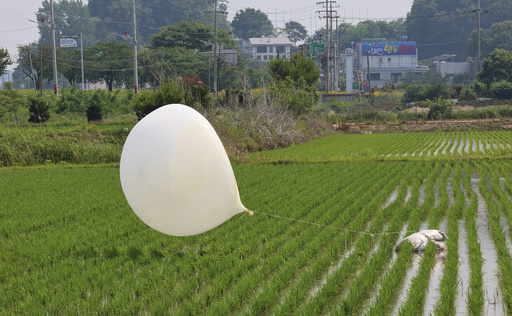SEOUL, South Korea (AP) — North Korea resumed launches of balloons likely carrying trash toward South Korea on Monday night, South Korea’s military said, in the latest round of a Cold War-style campaign on the Korean Peninsula.
The launches came days after North Korean leader Kim Jong Un and Russian President Vladimir Putin signed a major defense deal that observers worry could embolden Kim to direct more provocations at South Korea.
A statement from South Korea’s Joint Chiefs of Staff said the North Korean balloons were moving southeast. Earlier Monday it noted that northerly or northwesterly winds, favorable for the balloon launches, were forecast.
The statement asked South Korean citizens not to touch North Korean balloons and report them to military and police authorities. The military didn’t say how it would respond to new balloon launches. Separately, Seoul’s city government sent text messages telling citizens to beware of any falling object as the balloons were flying above the capital, an hour’s drive from the border.
Starting in late May, North Korea launched more than 1,000 balloons that dropped manure, cigarette butts, scraps of cloth, waste batteries and vinyl in various parts of South Korea. No highly dangerous materials were found. North Korea said its balloon campaign was a tit-for-tat action against South Korean activists who used balloons to fly political leaflets critical of its leadership across the border.
North Korea views front-line South Korean broadcasts and civilian leafleting campaigns as a grave provocation because it bans access to foreign news for most of its 26 million people. North Korea has reacted to past South Korean loudspeaker broadcasts and civilian balloon activities by firing rounds across the border, prompting South Korea to return fire, according to South Korea.
Kim’s influential sister, Kim Yo Jong, suggested Friday that North Korea would resume its balloon campaign in retaliation for South Korean civilian groups’ new round of leaflet activities. A South Korean group said it sent 20 balloons carrying 300,000 propaganda leaflets, 5,000 USB sticks with South Korean pop songs and TV dramas and U.S. one-dollar bills across the border on Thursday night.
“When you do something you were clearly warned not to do, it’s only natural that you will find yourself dealing with something you didn’t have to,” Kim Yo Jong said.
South Korean officials say they don’t restrict activists from flying leaflets to North Korea. A constitutional court ruling last year struck down a contentious law criminalizing such leafleting, calling it a violation of free speech.
Most of the previously dropped North Korean trash was paper, vinyl and cloth scraps of similar size, suggesting they were deliberately manufactured. The plastic bottles were without labels and caps, indicating they were removed to prevent the disclosure of information about North Korea’s consumer products, South Korea’s Unification Ministry said Monday.
The trash also included jeans, a banned item in North Korea; South Korean clothes that were badly damaged, likely by knives or scissors; and other items with imitation Disney characters.
In reaction to North Korea’s earlier balloon campaign, South Korea’s military on June 9 redeployed gigantic loudspeakers along the border for the first time in six years and resumed anti-North Korean propaganda broadcasts. The broadcasts reportedly included hits by K-pop sensation BTS such as “Butter” and “Dynamite,” weather forecasts and news on Samsung, the biggest South Korean company, as well as criticism of North Korea’s missile program and its crackdown on foreign videos.
Earlier Monday, South Korea, the United States and Japan issued a joint statement strongly condemning expanding military cooperation between Russia and North Korea. It said the North Korean-Russian moves should be of “grave concern” to efforts to promote peace on the Korean Peninsula, the global non-proliferation regime and support for the Ukraine people.
During a meeting in Pyongyang, North Korea’s capital, last Wednesday, Kim Jong Un and Putin struck a deal requiring each country to provide aid if attacked and vowed to boost other cooperation. Observers say the accord represents the strongest connection between the two countries since the end of the Cold War. The U.S. and its partners believe North Korea has been providing Russia with much-needed conventional arms for its war in Ukraine in return for military and economic assistance.
The South Korea-U.S.-Japan statement said the three countries reaffirmed their intention to further boost diplomatic and security cooperation to cope with North Korean threats and prevent an escalation of the situation. It said U.S. commitments to the defense of South Korea and Japan “remain ironclad.”
Last Saturday, a nuclear-powered U.S. aircraft carrier arrived in South Korea for a three-way Seoul-Washington-Tokyo military exercise that is expected to begin this month.
North Korea’s vice defense minister, Kim Kang Il, on Monday slammed the carrier’s deployment, calling it “the reckless option and action of the U.S.”
North Korea has previously called major joint U.S.-South Korean military drills an invasion rehearsal and responded with missile tests. North Korea maintains that U.S. hostility forced it to pursue nuclear weapons in self-defense.
The U.S. stations about 28,000 troops in South Korea, a legacy of the 1950-53 Korean War that ended with an armistice, not a peace treaty, leaving the Korean Peninsula in a technical state of war.



